



 I began writing biographies of artists as a promotion for my book business in 1997. The theory being that I would attract people to my website by giving them some free content and they would then buy some books from me.
Part one worked. Part two didn't. I retired from bookselling in 2005.
But the effort resulted in some odd implementations of the "biography" label—this being one of them.
Many books in my collection and that we sold in the Bud Plant Illustrated Books catalog had more than one illustrator – Spectrum being an excellent example.
I began writing biographies of artists as a promotion for my book business in 1997. The theory being that I would attract people to my website by giving them some free content and they would then buy some books from me.
Part one worked. Part two didn't. I retired from bookselling in 2005.
But the effort resulted in some odd implementations of the "biography" label—this being one of them.
Many books in my collection and that we sold in the Bud Plant Illustrated Books catalog had more than one illustrator – Spectrum being an excellent example.
Since 1994, Arnie and Cathy Fenner have published an annual collection called Spectrum - The Best in Contemporary Fantastic Art. If you're a fan of modern fantasy and sf art, this is a wonderful sampler of what's best in the field each year. It is the result of a juried show in which submitted work is evaluated by a panel of judges. Bud Plant has been on the panel for several years, so you know that they recruit the very best. Medals are awarded and hundreds of the best pieces are then compiled into the annual book. Rick Berry was on the cover of Spectrum 2 (at right), and inside you could find Charles Vess along with Leo and Diane Dillon, Frank Frazetta, Marshall Arisman, Simon Bisley, James Gurney, and quite literally hundreds of others. The variety of material presented makes these annuals an inexpensive way to see your favorites and to learn about artists you didn't know.
Spectrum 17 was published in 2010. They are still going strong!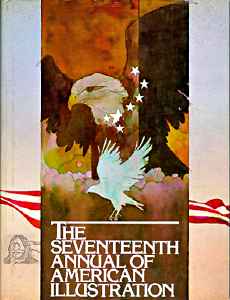 The
Society of Illustrators annual was the model for Spectrum.
Since 1959, the SofI has released an Illustrators annual
with the results of their yearly juried show, When I wrote this in 2000, I had just received
my copy of Illustrators 42 from Bud's Art Books. #52 is currently on sale (in 2011). The variety of work in these
books is staggering and the quality is always top notch. I'm often
treated to new work by many of my friends and past customers, like
Joe Rubinstein, Peter de Sève, and Leo and Diane Dillon for example.
Pick a year in which you have a liking for art styles and view
page after page of examples from your favorites and make some
new ones. I have a complete run of these annuals and they are
a great source of information for these biographies.
The
Society of Illustrators annual was the model for Spectrum.
Since 1959, the SofI has released an Illustrators annual
with the results of their yearly juried show, When I wrote this in 2000, I had just received
my copy of Illustrators 42 from Bud's Art Books. #52 is currently on sale (in 2011). The variety of work in these
books is staggering and the quality is always top notch. I'm often
treated to new work by many of my friends and past customers, like
Joe Rubinstein, Peter de Sève, and Leo and Diane Dillon for example.
Pick a year in which you have a liking for art styles and view
page after page of examples from your favorites and make some
new ones. I have a complete run of these annuals and they are
a great source of information for these biographies.
I have a question that has puzzled me for decades. Why don't most British books have copyright dates? Does anyone know? Not even some of the ANNUALS give a publication date. I've never understood this and it has certainly hindered the cause of bibliography over the years. Any insights?
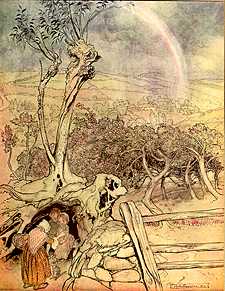 Other
entries in this category include Princess Elizabeth's Gift
Book (you might have heard of her, she's the one who graduated
to "Queen"), The Queen's Book of the Red Cross
(in time to sponsor another benefit book in 1939), King Albert's
Book, and The Blinded Soldiers and Sailors Gift Book.
The eclectic contents of these books don't seem to fit comfortably
into any other niche on my shelves. But (various) describes
them nicely.
Other
entries in this category include Princess Elizabeth's Gift
Book (you might have heard of her, she's the one who graduated
to "Queen"), The Queen's Book of the Red Cross
(in time to sponsor another benefit book in 1939), King Albert's
Book, and The Blinded Soldiers and Sailors Gift Book.
The eclectic contents of these books don't seem to fit comfortably
into any other niche on my shelves. But (various) describes
them nicely.
Earlier still, around the turn of the century, many of the famous magazines of the time would 'recycle' some of their published illustrations into elaborate and quite large presentation volumes aimed at the Christmas gift buyers. P.F. Collier in 1908 released Thirty Favorite Paintings, with large images, some few in color, by the famous illustrators whose work appeared in their magazine: Harrison Fisher, Frederic Remington, Maxfield Parrish, A.B. Frost, Gibson, Leyendecker, Sarah Stilwell, Keller, etc. Also in 1908, Judge published "Yours Truly" and One Hundred Other Original Drawings with b&w paintings and drawings by J.M. Flagg, Penrhyn Stanlaws, Frank Snapp, Charles Sarka and other lesser luminaries. Both of these books were about 11½" x 16".
In 1906, Life presented The Social Comedy. It was the latest in the (near) annual string of compilations begun in 1897 with Life's Comedy. Scribner's also had an early entry into the compilation field back in 1898 with Pictures From Scribner's. This featured individual plates by Gibson, Frost, Castaigne, Vierge, Abbey, Pyle, Wenzell and others.
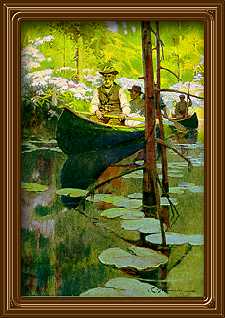
|

|
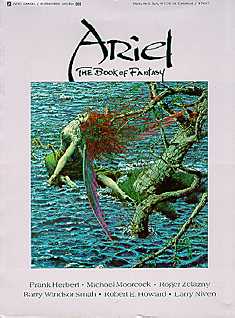
|
|
Frank Schoonover in Scribners Vol. XLI (1907) |
Ervine Metzl in Fortune Vol. IV No.1 (1932) |
Barry Windsor-Smith in Ariel Vol. 3 (1978) |
If this is the area of illustration in which you're interested, there's no better or more economical means of learning about it than to view the original magazines where these illustrators first displayed their work. I collect these source magazines, usually in bound volumes. Material from The Century, Scribner's, Harper's, St. Nicholas, Life, The Studio, Punch and others often show up in the pages of The Vadeboncoeur Collection of ImageS magazine.
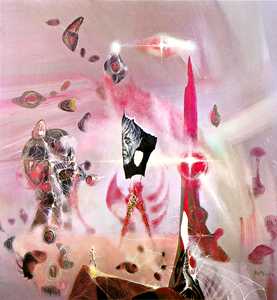 Then
there are the "Art of" books: The Art of Dungeons
and Dragons, The Art of Playboy, The Art of Rock,
etc. and books devoted to a group of artists: titles like Dream
Makers, The Flights of Icarus, or like Jones, Wrightson,
Kaluta and Windsor-Smith in The Studio or books devoted
to a specific genre like science fiction and/or fantasy art. Many
wonderful collections exist, often featuring many more artists
than I could possible list. Take, for instance, one of my science
fiction favorites, Tomorrow and Beyond which presents "Masterpieces
of Science Fiction Art" like the Richard Powers image at
left. It has over 300 color images from over 70 different illustrators.
Then
there are the "Art of" books: The Art of Dungeons
and Dragons, The Art of Playboy, The Art of Rock,
etc. and books devoted to a group of artists: titles like Dream
Makers, The Flights of Icarus, or like Jones, Wrightson,
Kaluta and Windsor-Smith in The Studio or books devoted
to a specific genre like science fiction and/or fantasy art. Many
wonderful collections exist, often featuring many more artists
than I could possible list. Take, for instance, one of my science
fiction favorites, Tomorrow and Beyond which presents "Masterpieces
of Science Fiction Art" like the Richard Powers image at
left. It has over 300 color images from over 70 different illustrators.
 For modern samples of old illustrations,
see:
For modern samples of old illustrations,
see:| The Vadeboncoeur Collection of Knowledge | Jim Vadeboncoeur, Jr. 1999 |
| The Vadeboncoeur Collection of ImageS | Jim Vadeboncoeur, Jr. 2001-2011 JVJ Publishing |
|
Illustrations are copyright by their
respective owners. This page written, designed & © 1999 by Jim Vadeboncoeur, Jr. Updated 2011. |
